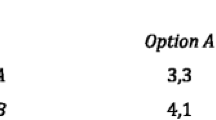Abstract
Philosophers and economists write about collective action from distinct but related points of view. This paper aims to bridge these perspectives. Economists have been concerned with rationality in a strategic context. There, problems posed by “coordination games” seem to point to a form of rational action, “team thinking,” which is not individualistic. Philosophers’ analyses of collective intention, however, sometimes reduce collective action to a set of individually instrumental actions. They do not, therefore, capture the first person plural perspective characteristic of team thinking. Other analyses, problematically, depict intentions ranging over others’ actions. I offer an analysis of collective intention which avoids these problems. A collective intention aims only at causing an individual action, but its propositional content stipulates its mirroring in other minds.
Similar content being viewed by others
References
Bacharach M. (1999). Interactive team reasoning: a contribution to the theory of cooperation. Research in Economics, 53, 117–147
Bardsley N. (2000). Interpersonal interaction and economic theory: the case of public goods. Annals of Public and Cooperative Economics 71, 191–228
Bjerring A (1978): The tracing procedure and a theory of rational interaction. In: Hooker C.A., Leach J., McClennen E.(Eds). Foundations and applications of decision theory. Reidel, Dordrecht, p. 4-3
Bratman M. (1992). Shared cooperative activity. Philosophical Review 101, 327–342
Bratman, M. (1997). I intend that We J. In R. Tuomela, & G. Holmstrom-Hintikka (Eds.), Contemporary action theory, social action (vol. 2, pp. 49–63). Dordrecht: Kluwer.
Camerer C.F., Ho T., Chong K. (2004). A cognitive hierarchy model of games. Quarterly Journal of Economics, 119, 861–898
Davis J.B. (2003). Collective intentionality, complex economic behavior, and valuation. Protosociology, 18–19, 163–183
Elster J. (1983). Explaining technical change. Cambridge University Press, Cambridge
Gilbert M. (1981):Game theory and social convention. Synthese, 46, 41–93
Gilbert M. (1989). On social facts. Routledge, London
Hargreaves H.S., Hollis M., Lyons B., Sugden R., Weale A. (1992). The theory of choice. Basil Blackwell, Oxford
Harsanyi J. (1975). The tracing procedure. International Journal of Game Theory 4, 61–94
Hollis M. (1998). Trust within reason. Cambridge University Press, Cambridge
Hurley S. (1989). Natural reasons. Oxford University Press, New York
Kutz C. (2000). Acting together. Philosophy and Phenomenological Research, 61, 1–31
Lewis D.K. (1969). Convention: A philosophical study. Harvard University Press, Cambridge, MA
Mehta J., Starmer C., Sugden R. (1994) The nature of salience: an experimental investigation. American Economic Review, 84, 658–673
Parfit (1984). Reasons and persons. Clarendon, Oxford
Peacocke C. (2005). Joint attention: its nature, reflexivity, and relation to common knowledge. In: Eilan N., Hoerl C., McCormack T., Roessler J. (Eds). Joint attention: communication and other minds. Oxford University Press, Oxford, pp. 298–324
Regan D. (1980). Utilitarianism and cooperation. Oxford University Press, Oxford
Sartre, J. P. (1943). Being and nothingness, H. Barnes, (Trans). London: Methuen. 1976.
Schelling T. C(1960). The strategy of conflict. Harvard University Press, Cambridge, MA
Searle J.R. (1990). Collective intentions and actions. In: Cohen P.R., Morgan J., Pollack M.E. (Eds). Intentions in communication. MIT Press, Cambridge, pp. 401–415
Skyrms B. (1989). Correlated equilibria and the dynamics of rational deliberation. Erkenntnis, 31, 347–364
Stahl D.O., Wilson P. (1995). On players’ models of other players. Games and Economic Behavior 10, 218–254
Sugden R. (1993). Thinking as a team. In: Paul E.F., Miller F.D., Paul J. (Eds). Altruism. Cambridge University Press, Cambridge, p. 5-4
Sugden R. (1995). A theory of focal points. Economic Journal, 105, 533–550
Swindler J. K. (1996). Social intentions: aggregate, collective and general. Philosophy of the Social Sciences 26, 61–76
Tuomela R. (1984). A theory of social action. Kluwer, Dordrecht
Tuomela R., Miller K. (1988). We-intentions. Philosophical Studies 53, 367–389
Tuomela R. (1995). The importance of us. Stanford University Press, Standford, CA
Velleman J.D. (1997). How to share an intention. Philosophy and Phenomenological Research 57, 29–50
Williamson O. (1975). Markets and hierarchies. Macmillan, New York
Author information
Authors and Affiliations
Corresponding author
Rights and permissions
About this article
Cite this article
Bardsley, N. On collective intentions: collective action in economics and philosophy. Synthese 157, 141–159 (2007). https://doi.org/10.1007/s11229-006-9034-z
Received:
Accepted:
Published:
Issue Date:
DOI: https://doi.org/10.1007/s11229-006-9034-z




